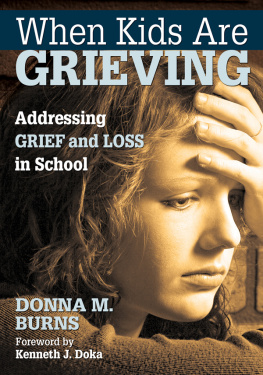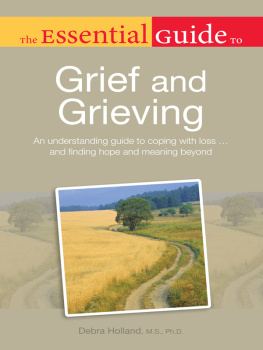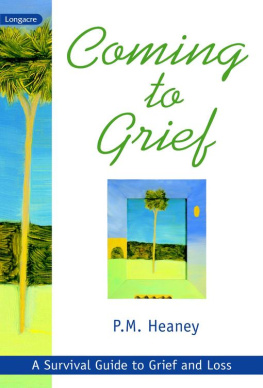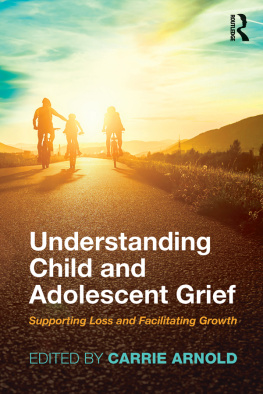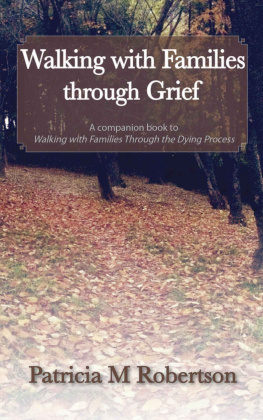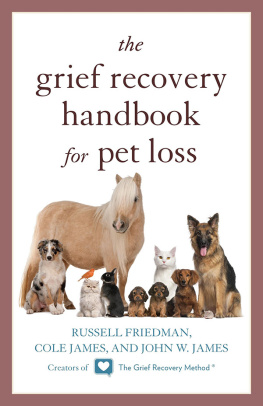It is because of your interest and concern for seeking to understand the many ways in which children and adolescents grieve and your desire to provide them with comfort, guidance, and support that this book is dedicated to you, the school professional.
Thank you.
Copyright 2010 by Donna M. Burns
First Skyhorse Publishing edition 2014
All rights reserved. No part of this book may be reproduced in any manner without the express written consent of the publisher, except in the case of brief excerpts in critical reviews or articles. All inquiries should be addressed to Skyhorse Publishing, 307 West 36th Street, 11th Floor, New York, NY 10018.
Skyhorse Publishing books may be purchased in bulk at special discounts for sales promotion, corporate gifts, fund-raising, or educational purposes. Special editions can also be created to specifications. For details, contact the Special Sales Department, Skyhorse Publishing, 307 West 36th Street, 11th Floor, New York, NY 10018 or .
Skyhorse and Skyhorse Publishing are registered trademarks of Skyhorse Publishing, Inc., a Delaware corporation.
Visit our website at www.skyhorsepublishing.com.
10 9 8 7 6 5 4 3 2 1
Library of Congress Cataloging-in-Publication Data is available on file.
Cover design by Karine Hovespian
Print ISBN: 978-1-62914-776-5
Ebook ISBN: 978-1-63220-186-7
Printed in the United States of America
Contents
Kenneth J. Doka
Foreword
D onna Burnss new book, When Kids Are Grieving: Addressing Grief and Loss in School, is most welcome. There are a number of reasons to hail this new addition to the literature. Most importantly, children are often disenfranchised grieverstheir grief is unrecognized and unacknowledged by those around them. There are many reasons for this. Their grief may not be recognized since it often appears in indirect wayssleep disturbances, physical complaints, acting out behaviors, and regressive behaviors. Children and adolescents may be inarticulate in identifying the loss that underlies their reactions. Overwhelmed and frightened by their parents grief, they may seek to spare their families, grieving alone. Their parents, also likely mourning the loss, may be unable to see beyond their own grief. They may have neither the energy nor the skills to succor their children.
Schools can and must play a critical role. We often forget the significant role that schools play in the life of students. Beyond the critical academic role, schools are a social and developmental arena offering critical contact and interaction with peers and adults outside the family. Schools offer opportunities for children and adolescents to explore and to develop their talents and to test their skills.
Schools also offer an early warning systema place where objective observers can begin to notice changes in behaviors or grades that might indicate difficulties heretofore unrecognized. Most importantly, they offer the possibility of informal and formal support to a child struggling with grief and loss.
When Kids Are Grieving: Addressing Grief and Loss in School is designed to help. As Dr. Burns likes to say, it is a hybrid book: part text, part resource, and part workbook. It is, most importantly, an accessible and valued resourcedesigned first and foremost for the school professional. This is not to say that clinicians will not find the book useful. However, the fact that it is designed for the school professional means it is both focused and practicaloffering teachers, administrators, and guidance counselors critical information as they approach students who are grieving.
The book has great sensitivity. That sensitivity begins by acknowledging that children grieve many lossesnot just death, but losses such as divorce, separation, or the other many losses children and adolescents experience on the way to adulthood. There is sensitivity to the developmental process, recognizing that different methods and approaches must be used with children and adolescents and acknowledging that even these approaches must be constantly modified as the child continues to develop. It is sensitive to the ways that children and adolescents grieve, acknowledging both similarities and differences in the ways that adults might experience grief. It is sensitive to the constraints that school personnel may face, acknowledging the limits to the support they can offer and urging effective partnerships with other community organizations.
Robert Kastenbaum once wrote an article titled The Kingdom Where Nobody Dies (1972). His point in that piece is that adults often like to think of childhood as a kingdom where nobody dies. Adults attempt then to protect children from death. In fact, adults are only protecting themselves from exposure to the childs evident pain and loss. Try as they may, schools cannot try to close the castle moatpretending that loss, death, and grief have no role beside reading, writing, and arithmetic. With this resource, they no longer have tothey now have the tools for a sustained siege.
Kenneth J. Doka, PhD
Professor of Gerontology, The College of New Rochelle Senior Consultant, The Hospice Foundation of America
Preface
S chool is often the stage upon which both the triumphs and tragedies of childrens lives are played out. Within this microcosm, much more than teaching and learning is taking place because at any given time in any given school, kids are grieving. Perhaps a pet has died or parents are divorcing; a student may be bullied or a classmate may have committed suicide. Whatever life event a child is experiencing will more than likely unfold on this stage.
As a professor of educational psychology, I have the privilege of teaching current and future educators and counseling and school psychologists who routinely request information about a variety of grief and loss issues. Their genuine interest in and concern for the wellbeing of children and teens prompted me to write this book.
The scope of information on grief and loss is extensive, and to the uninitiated, the vast body of literature available can be both confusing and overwhelming. This book serves as a primer of sorts, introducing relevant concepts in a concise, user-friendly format. Classic theories are linked with current perspectives to provide a rich source of information that captures the dynamic nature of children and teens and their grief and loss experiences.
This hybrid bookpart text, part resource, part workbook designed for you, the reader, addresses the grief and loss experiences of children and adolescents and provides you with readily available information, materials, and tools specific to your needs. For example, chapter titles are posed as questions because, typically, when someone reaches for a textbook, its to find an answer to a question. This format will enable you to go directly to the chapter that addresses your concern. Each chapter opens with a relevant and thought provoking quote that segues to the chapter content. Every chapter contains a variety of tools such as charts, checklists, tables, and activities and includes an invitation to share experiences. Terminology specific to grief and loss is introduced in boldface type and included in a glossary. Chapters conclude with a reflection and list of key terms.
Counseling and school psychologists are typically the first ones educators and staff consult when any type of crisis arises at school. As such, they often assume a leadership role in the training of other school personnel. This book serves as

